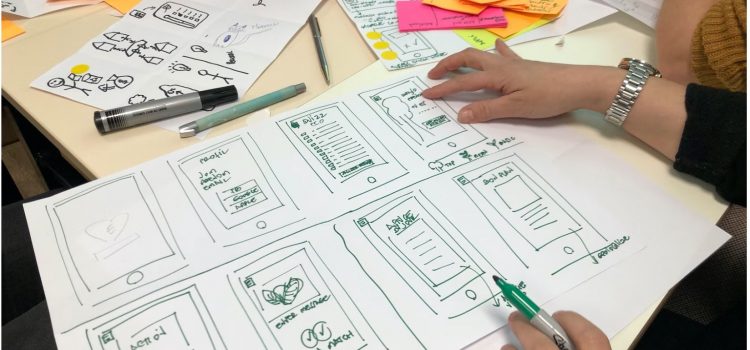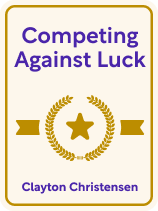

This article is an excerpt from the Shortform book guide to "Competing Against Luck" by Clayton Christensen. Shortform has the world's best summaries and analyses of books you should be reading.
Like this article? Sign up for a free trial here.
Is there a secret to new product innovation? How can you design a new product that customers want to buy?
In Competing Against Luck, renowned business consultant Clayton Christensen teaches you how to identify the tasks your customers want to accomplish to fuel new product innovation. He shares his framework for uncovering hidden customer expectations and crafting unique experiences.
Read on to learn Christensen’s techniques for new product innovation in business.
The Secret to New Product Innovation
In his book Competing Against Luck, business consultant and best-selling author Clayton Christensen explains how to generate profitable business innovations. He claims that the first step to new product innovation is to identify the task you’re trying to resolve with your product. Christensen defines a task as a specific purpose that customers accomplish by buying a product, such as “entertain me and help me forget about work during my vacation.”
Let’s discuss a few of Christensen’s techniques for identifying customer tasks to inspire new product innovation.
1) Interview Customers
One of the most reliable ways to identify tasks is to talk with customers, contends Christensen. Because tasks are so situation-dependent, you need a detailed picture of the customer’s life to fully understand the task that motivated them to make the purchase. A one-on-one conversation is the best way to uncover this level of detail.
(Shortform note: In The Mom Test, Rob Fitzpatrick warns that the fatal flaw of one-on-one conversations with customers is that they’ll instinctively tell you what they think you want to hear—typically, that they like your product and would buy it. As a result, most customer feedback actively pushes you toward failure by convincing you that bad product ideas are good. To avoid this, keep your conversation grounded in facts about the customer’s life that they can’t twist to make you feel better. For example, instead of asking a customer if they would buy and use your new smoothie blender, ask them about their recent eating habits to see if they would actually want an easier way to eat more fruits and vegetables.)
To identify a task associated with a purchase in sufficient detail to inspire new product innovation, you need all the context from the customer’s life that’s relevant to that purchase. For any purchase that a customer makes, there are encouraging factors influencing them to buy it and opposing, discouraging factors influencing them not to buy it. The encouraging factors include the problems causing them pain and the attractive benefits of the new product. The discouraging factors are the existing, habitual ways the customer solves their problems and their doubts and fears about the new product (that it’ll be a waste of money or make their life worse).
Christensen recommends asking customers to tell you the story of their life leading up to a specific purchase and identifying the encouraging and discouraging factors at play, as they’re all components of the task driving the purchase.
For example, a customer might describe the last time he bought a winter coat: He was planning to take a trip to Canada to go camping with some friends. He thought about buying a warm, puffy winter coat. However, he worried that his friends would make fun of him, so he decided to buy a thin coat instead and ended up suffering through the bitter cold. Stories like this illuminate the encouraging factors (I want to be warm) and discouraging factors (I don’t want my friends to make fun of me) customers consider when making a purchase.
With this story, you could set out to design a coat that solves the following task: “Keep me warm in the cold outdoors without drawing too much attention to how I look.”
2) Study the Tasks Around You
Another way to inspire new product innovation is to study the tasks around you. Christensen maintains that as you go about your daily business, you’ll naturally encounter tasks that aren’t being done well. Every consistently difficult task in life is an opportunity for innovation, so keep your eyes open. Whenever you or someone around you encounters something frustrating or has tried and failed to resolve a specific task for an extended period of time, there’s a task that the market is failing to address.
(Shortform note: While you’re noticing difficult tasks around you, how do you know which are worth turning into products or services? In The $100 Startup, Chris Guillebeau advises only starting a business to solve a problem if you’re passionate about the problem and think you would enjoy working to solve it—even if it requires a lot of administrative work.)
In particular, Christensen recommends taking note if someone around you gets creative and devises a unique solution to a problem they have. People who invent DIY solutions are trying to resolve a task that no one has designed a product for yet, making it a golden opportunity for you to fill a gap in the market. For instance, if you see someone taping blankets over their windows to block out sunlight, you could design easy-to-install window blinds that stick directly to a window frame.
(Shortform note: The DIY solutions that those around you invent may be better than anything available on the market because frustrating circumstances frequently push people into “creative desperation.” When we’re in a stressful situation and need a solution, we scramble to make connections that we otherwise wouldn’t have, leading us to develop genius workarounds for our own use. In contrast, research and development teams in major companies are unlikely to be in this state of creative desperation, since they’re not personally frustrated by the problem they’re trying to solve.)
Similarly, pay attention if you see someone using a product to resolve a task that its designers didn’t intend, argues Christensen. Such mismatches often indicate that a version of the product designed for that task would be in high demand. For example, if you work for a sunglasses company and see someone using your sunglasses to block out blue light while working on a computer, it might be an opportunity to create a blue-light-blocking line of sunglasses.
(Shortform note: To discover new consumer tasks in this way, Marty Cagan (Inspired) recommends that product designers intentionally incorporate flexibility into their products so that users can use them in unexpected ways. For example, the founders of eBay intentionally created an “everything else” category so users could sell things online that the founders couldn’t have predicted with the other categories. This paid off when eBay discovered that many of its users were selling used cars through the service, prompting them to further develop the car-selling function of their website.)
3) Design a Product to Solve a Task
Once you’ve defined a consumer task in detail, design a product that accomplishes that task in a satisfying way. According to Christensen, the key to new product innovation is to focus on selling a full experience, not just a product. Since every task is tied intrinsically to a specific situation, you can directly work to improve the experience of that specific time and place rather than focusing on features you can add to the product. This may involve extending your focus beyond the core functionality of your product and instead innovating the entire process of purchasing and using your product.
For example, perhaps you sell barbeque grills, and you’ve identified that customers buy your grills to accomplish the task of “help me host outdoor events and serve great food.” You can then innovate to make this entire experience as fulfilling as possible: Offer free delivery and setup, and throw in a free book of recipes. This way, customers don’t have to deal with the potentially frustrating experiences of setting up the grill or researching what to cook on it.
| The Experience May Matter More Than the Product In All Marketers Are Liars, Seth Godin takes this idea further, arguing that the experience surrounding your product is what the customer is really buying. Since customers experience your product from a subjective point of view, changing the conditions in which you present your product can radically change the product itself (from the customer’s perspective). Even if you don’t have a unique product to sell, look past its core functionality and craft a unique experience around it. In doing so, you give value to the customer that they can’t get anywhere else. For instance, if you create an intricately decorated goth-themed café and give your drinks names like Wretched Tears and Decaying Dread, customers will believe that the drinks taste different and special, even if they’re materially the same as those you could get anywhere else. |

———End of Preview———
Like what you just read? Read the rest of the world's best book summary and analysis of Clayton Christensen's "Competing Against Luck" at Shortform.
Here's what you'll find in our full Competing Against Luck summary:
- How to analyze consumer demand to guide product innovation
- How you can design and sell a product that can't possibly fail
- Tips for increasing your company's chances of success






